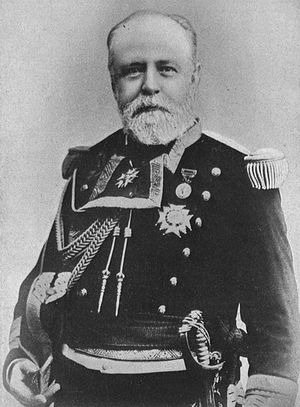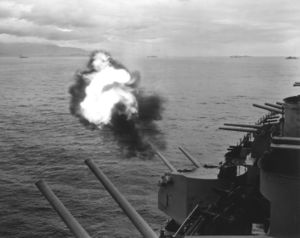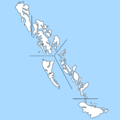Battle of the San Carlos Islands
| Operation Valdivo | |||||||
|---|---|---|---|---|---|---|---|
| Part of the Creeperian Civil War | |||||||
 Clockwise from top-left: Ruins of the San Carlos Mission, Romerist artillery targeting Miguelist ships, Sinking of the battleship BNC Carlos Marx by the destroyer BIC Cuscatlán. | |||||||
| |||||||
| Belligerents | |||||||
|
|
| ||||||
| Commanders and leaders | |||||||
|
|
| ||||||
| Units involved | |||||||
|
|
| ||||||
| Strength | |||||||
|
1 battleship 3 heavy cruisers 3 light cruisers 6 destroyers 6 submarines 5 transport ships 10,000 sailors 10,000 soldiers |
4 heavy cruisers 4 light cruisers 8 destroyers 6 submarines 200 aircraft 5,900 sailors 400 airmen 10,000 soldiers | ||||||
| Casualties and losses | |||||||
|
1 battleship sunk 1 heavy cruiser sunk 1 heavy cruiser damaged 2 light cruisers sunk 2 destroyers sunk 2 destroyers damaged 1 destroyer captured 5 submarines sunk 1 submarine captured 5 transport ships sunk 6,984 sailors killed 833 sailors captured 8,719 soldiers killed 891 soldiers captured |
2 heavy cruisers sunk 2 heavy cruisers damaged 2 light cruisers sunk 1 light cruiser damaged 4 destroyers sunk 2 destroyers damaged 5 submarines sunk 1 submarine damaged 121 aircraft destroyed 42 aircraft damaged 2,763 sailors killed 211 airmen killed 31 airmen captured 783 soldiers killed | ||||||
| 2,449 civilians killed | |||||||
The Battle of the San Carlos Islands (Creeperian: Batalla de las'Islas San Carlos), also known as Operation Valdivo (Creeperian: Operación Valdivo), and sometimes called the Battle of the Two José's (Creeperian: Batalla de los'Dos José's), the Battle of the Qarl Marx Islands (Creeperian: Batalla de las'Islas Carlos Marx) and the Battle of Easter Week (Creeperian: Batalla de Semana Pasqua), was a major naval military engagement of the Creeperian Civil War between the National Council for Peace and Order and the Catholic Imperial Restoration Council which occurred from 17 to 29 April 1938 in the San Carlos Islands, the only such military engagement in the department throughout the entire war due to its distance away from the Creeperian mainland. The battle was a part of a National Council operation to land soldiers on the San Carlos Islands and begin a conquest of the islands from Imperial Council control.
Battle began on 17 April 1938, Easter Sunday, when ships of the National Council opened fire on Imperial Council positions in Cámarillo and Santa Catalina on the islands of Colón, where the 10,000 National Council soldiers intended to make landfall. Through 20 April 1938, two of the transport ships were sunk by the Imperial Council, killing many of the soldiers on board, and by then, an effective stalemate ensued as the National Council was unable to make any landing while the Imperial Council was unable to force a National Council retreat. On 23 April 1938, a third transport ship was sunk by the Imperial Council, but the National Council refused to retreat. A second attempt at a landing occurred on 25 April 1938, however, both transport ships were sunk before they would deploy soldiers to land, and the Imperial Council began a counteroffensive to force a National Council retreat. On 29 April 1938, following the sinking of the National Council battleship BNC Carlos Marx, the remaining ships of the National Council retreated but continued to come under heavy Imperial Council fire, ending the one week five day-long battle in an Imperial Council victory.
The battle is considered to be the largest naval battle of the Creeperian Civil War, and, until the Battle of the Glaceis Ocean of 30 to 31 March 2020, the largest naval battle in Creeperian and world history. A total of forty-six ships were involved in the battle, and of them, twenty-nine were sunk, nine were damaged, and two were captured. The National Council had a strength of 20,000 men while the Imperial Council had a strength of 16,300 men. The Imperial Council also deployed 200 aircraft during the battle. The battle remains the deadliest in history, claiming the lives of 21,909 combined military personnel and civilians. Heavy damaged was caused across Colón in Cámarillo and Santa Catalina.
The battle led to the solidification of Imperial Council control over the San Carlos Islands for the remainder of the Creeperian Civil War and no serious attempt to take control of the San Carlos Islands by the National Council was attempted for the remainder of the war. The battle is commemorated ever 17 April with a military parade in Cámarillo in celebration of the Imperial Council victory over the National Council in the battle. The historic San Carlos Mission, destroyed during the battle by bombardment from National Council ships, serves partially as a memorial to the battle as it was never reconstructed following the war and remains in ruins. The battle is considered one of the most important battles of the civil, along with the Battle of Ciutat dels Àngels, the Battle of Nuevo Xichútepa, the Siege of San Salvador, and the Battle of the Zapatista River. The battle, and then the later and disastrous 1943 Battle of Cabo de Palos, severely weakened the power of the National Council's navy. It also weakened the Imperial Council's navy, but not to the extent as it was for the National Council, which lost several ships and men. The commanding Admirals of both sides, José Obregón Galván and José Salinas Tejón, were both killed during the battle.
Contents
Background
On 2 January 1933, Emperor Adolfo IV died to Creeperian Malaria, sparking a succession crisis in Creeperopolis. The throne was claimed by his two sons: Romero I and Miguel VII, both of whom believed in two different political ideologies; Romero I held far-right fascist political beliefs while Miguel VII held far-left communist-political beliefs, which was seen as a potential problem even before the death of Adolfo IV. When he died, both proclaimed themselves as Emperor and the two political factions of the Parliament, the Creeperian Conservative Coalition and the People's Social Coalition, declared their support for the Emperor which more aligned with them. Later that day, soldiers loyal to both Emperors skirmished in San Salvador del Norte, beginning the Creeperian Civil War.
When news of the civil war's beginning arrived in the San Carlos Islands, Captain General José Reina Andrade of the National Conservative Party (PCN) declared the islands' allegiance with Romero I and the Catholic Imperial Restoration Council. He ordered the arrest of the opposition and had the islands' military occupy major cities to prevent any revolts from occurring. The arrests and subsequent imprisonments and executions have been known as the Red Days of January.
Prelude and planning
In 1937, Admiral José Obregón Galván and his advisors began drafting plans for a National Council invasion of the San Carlos Islands, the capture of which would be a great strategic victory due to the islands' position in the Southern Ocean and a massive blow to Imperial Council morale due to the historic significance of the islands to Catholicism and Creeperopolis. He referred to the islands as the Qarl Marx Islands, in Creeperian the Islas Carlos Marx, as a play on the name "San Carlos Islands" and in an effort to remove Catholic names from National Council possessions, which was occurring in the other cities and departments controlled by the National Council in Creeperopolis.
A final plan was completed by early-1938. The National Council flotilla would consist of nineteen warships and five troop transport ships which would be divided into two fleets, numbered one and two, which would be further divided into four sectors, numbered one through four. Each sector would have at least one transport ship, with the exception of the second, which would have two.
The two fleets would separate, with the first headed towards the island of Cámarillo and the other towards the island of Santa Catalina. The first fleet would divide itself into the first and second sectors and make three separate landings, one by the first sector just east of the capital city of Cámarillo and two by the second sector at the mouth of the Strait of Cámarillo. With the landings, the first fleet would be bombarding cities and Imperial Council positions on the island, with the first sector directly bombarding the city of Cámarillo. The second fleet would head towards the island of Santa Catalina, and there, it would split into the third and fourth sectors, each making one landing. The third sector would be making landings just south of the city of Santa Catalina and the fourth sector would be making landings northeast of Santa Catalina. During the landings, the third sector would be bombarding the city of Santa Catalina.
The plan was to secure positions on the islands and to surround both Cámarillo and Santa Catalina, forcing their surrenders in the process and gaining a strong foothold in the most important viceroyalty of the San Carlos Islands. The landings would also secure the National Council airfields so that they can utilize the aircraft they had onboard the transport ships, as they had no ability to utilize them during the initial invasion as Creeperopolis never developed aircraft carriers during the civil war.
Order of Battle
National Council

The flotilla of the National Council consisted of one battleship, three heavy cruisers, three light cruisers, six destroyers, six submarines, and five transport ships. On board the transport ships were 10,000 soldiers who planed to make landings on the San Carlos Islands and begin the capture of the islands.
- 12th Flotilla – Admiral José Obregón Galván
- Fleet 1 – Vice Admiral Martín Mena Campos
- Sector 1 – Rear Admiral Alfonso Velázquez Cortéz
- BNC Carlos Marx – Captain Juan Sotelo Calvo (battleship)
- BNC Cazalla Beldad – Lieutenant Commander Leonardo Trejo Hidalgo (light cruiser)
- BNC Adolfosburg – Lieutenant Commander Hernán Ortega Molina (destroyer)
- BNC Puerto Senvar – Lieutenant Commander Bernabé Fernández Molina (destroyer)
- BNC DA 6 – Commander Alexander Tassis Obregón (submarine)
- BNC Kapahu Alana – Captain Jorge Videla Ramos (transport)
- Sector 2 – Rear Admiral Bernardo Zaldívar Hidalgo
- BNC Bandera Roja – Commander Emiliano Guerrero Álvarez (heavy cruiser)
- BNC Lasca Campos – Lieutenant Commander José Ramírez Melléndez (light cruiser)
- BNC Denshire – Lieutenant Commander José Barrie Delgado (destroyer)
- BNC DA 1 – Commander Martín Serafín Dávalos (submarine)
- BNC La'Capital – Captain José Figueroa Figueroa (transport)
- BNC Ramos – Captain Roberto Azaña Ramos (transport)
- Sector 1 – Rear Admiral Alfonso Velázquez Cortéz
- Fleet 2 – Vice Admiral José Guerrero Yagüe
- Sector 3 – Rear Admiral Miguel Serafín Ureña
- BNC Estrella Roja – Commander Manuel Gaitán Bolívar (heavy cruiser)
- BNC Tasis Quesada – Lieutenant Commander Gustavo Encarnación Casanova (destroyer)
- BNC San Miguel – Lieutenant Commander Juan Zaldívar Fuentes (destroyer)
- BNC DA 9 – Commander Rodolfo Ureña Tejón (submarine)
- BNC DA 3 – Commander Rubén Ornella Pérez (submarine)
- BNC al-Morad – Captain José Huerta Fuentes (transport)
- Sector 4 – Rear Admiral Miguel Colorado Salinas
- BNC Internacional – Commander Santiago Jalisco Mentín (heavy cruiser)
- BNC Rubio Noboa – Lieutenant Commander Mario Salinas Salinas (light cruiser)
- BNC San Luís – Lieutenant Commander Marcos Jiménez Nuñez (destroyer)
- BNC San Miguel – Lieutenant Commander Juan Zaldívar Fuentes (destroyer)
- BNC DA 11 – Commander José Payés Merino (submarine)
- BNC DA 22 – Commander Adolfo Ureña Tejón (submarine)
- BNC Moreno Dávalos – Captain Francisco Monroy López (transport)
- Sector 3 – Rear Admiral Miguel Serafín Ureña
- Fleet 1 – Vice Admiral Martín Mena Campos
- 17th Infantry Division – Lieutenant General Alberto Payés Ramírez
- 21st Infantry Battalion – Brigadier Hernán Soto Pizarro
- 22nd Infantry Battalion – Brigadier Matías Altamirano Monroy
- 27th Infantry Battalion – Brigadier Humberto Suárez Zúñiga
- 38th Infantry Battalion – Brigadier Julio Oñate Salazar
- 51st Infantry Battalion – Brigadier Martín Zaldívar Cadena
Imperial Council

The flotilla of the Imperial Council consisted of four heavy cruisers, four light cruisers, eight destroyers, and six submarines.
- 19th Flotilla – Admiral José Salinas Tejón
- 1st Fleet – Vice Admiral Juan Huerta Casanova
- Sector 1 – Rear Admiral Pedro Trejo Mendoza
- BIC Xichútepa – Commander Marcos Yagüe Obregón (heavy cruiser)
- BIC Huitzilopochtli – Lieutenant Commander Pedro Mármol Hirezi (light cruiser)
- BIC Cuscatlán – Lieutenant Commander José Goméz Alvarado (destroyer)
- BIC Metapán – Lieutenant Commander Gonzalo Herrador Rosales (destroyer)
- BIC DA 27 – Commander Alberto Munguía Payés (submarine)
- BIC DA 28 – Commander Federico Valdéz Sol (submarine)
- Sector 2 – Rear Admiral Xavier Justo Melléndez
- BIC Cuyua – Commander Miguel Castillo Yanes (heavy cruiser)
- BIC Tezcatlipocachtli – Lieutenant Commander Santiago González Portillo (light cruiser)
- BIC Tehuacán – Lieutenant Commander Juan Sánchez Ureña (destroyer)
- BIC Guacotecti – Lieutenant Commander Antonio Castañeda Castro (destroyer)
- BIC DA 22 – Commander Gerardo Dueñas Díaz (submarine)
- Sector 1 – Rear Admiral Pedro Trejo Mendoza
- 2nd Fleet – Vice Admiral Manuel Piñón Ureña
- Sector 3 – Rear Admiral Francisco Vázquez León
- BIC Tecúa – Commander Marcos Pérez Jiménez (heavy cruiser)
- BIC Chicomexochtli – Lieutenant Commander Isaías Ramírez Céren (light cruiser)
- BIC Ixtepetl – Lieutenant Commander Raúl Alvarado Herrador (destroyer)
- BIC Nanahuatzin – Lieutenant Commander José Morales Fuentes (destroyer)
- BIC DA 12 – Commander Juan Fuentes Garrido (submarine)
- BIC DA 32 – Commander Porfirio Cruz Mori (submarine)
- Sector 4 – Rear Admiral Pedro Menéndez Portillo
- BIC Motzocho – Commander Romero Díaz Huerta (heavy cruiser)
- BIC Tonatiuh – Lieutenant Commander Sebastián Juárez Tejada (light cruiser)
- BIC Palafox Mendoza – Lieutenant Commander Refugio González Flores (destroyer)
- BIC Suárez Mendoza – Lieutenant Commander Ramón Corral Verdugo (destroyer)
- BIC DA 28 – Commander Vicente Riva Guerrero (submarine)
- Sector 3 – Rear Admiral Francisco Vázquez León
- 1st Fleet – Vice Admiral Juan Huerta Casanova
- 12th Air Force Wing – General Gerardo Alvarado Álvarez
- 7th Air Force Division – Lieutenant General Augusto Colorado Juárez
- 8th Air Force Division – Lieutenant General Pedro Cortéz Pizarro
- 20th Infantry Division – Lieutenant General Faustino Ugarte Ulloa
- 35th Infantry Battalion – Brigadier Héctor Moreno Moreno
- 44th Infantry Battalion – Brigadier Fabián Mena Mina
- 48th Infantry Battalion – Brigadier Gustavo Obregón Pinochet
- 51st Infantry Battalion – Brigadier Eduardo Quijada Sandoval
- 60th Infantry Battalion – Brigadier Diego Ureña Fuentes
Battle
Initial National Council attacks: 17–20 April

At 7:00am ISC on 17 April 1938, the second sector of the National Council's flotilla arrived at its designated landing zone and began bombarding the coastline in preparation for the landings. In the hours prior, Imperial Council ships reported the presence of the incoming flotilla to Cámarillo, which immediately deployed its own flotilla to repel the National Council. Submarines had previously planted mines along the coastlines of Cámarillo and Santa Catalina in 1936, fearing such a landing, and the troop transport ship BNC Ramos collided with one of the planted mines, sinking the ship and killing most of its 2,500 soldiers. The other troop transport ship, the BNC La'Capital, aborted its planned landing due to the mine presence in the area. The first sector's troop transport ship and battleship, the BNC Carlos Marx, came under attack from aerial bombardment and land-based artillery fire. No landing was attempted due to the heavy Imperial Council ship presence in the area.
In Santa Catalina, on 18 April 1938, another troop transport ship, the BNC Moreno Dávalos, also collided with a mine, sinking and killing most of its soldiers and crew, effectively making the fourth sector redundant as its only transport ship was destroyed. It withdrew and reunited with the third sector to defend its transport ship. The third sector was made aware of the sinking of two transport ships and ordered its transport ship to not pursue any landing attempt.
Effective deadlock and stalemate: 21–24 April
Imperial Council counteroffensive: 25–29 April
Casualties
Aftermath
National Council prisoners
Imperial Council prisoners
Damages
Impact on the war and legacy
Memorials
See also
- Operation Esclaveta – a canceled covert National Council operation to incite a rebellion in Esclaveta







